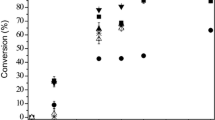Abstract
Cassava residue was liquefied by using ethylene glycol (EG), ethylene carbonate, propylene carbonate and polyethylene glycol (molecular weight: 400 g/mol) as the liquefaction reagent respectively at the temperature of 130–170 °C with sulfuric acid as the catalyst. The influences of liquefaction parameters, such as the type of liquefaction reagents, mass ratio of EG/cassava residue, liquefaction temperature and time on the properties of the products were discussed. The optimum liquefaction conditions were obtained when the mass ratio of EG/cassava residue was 6:1 (w/w), the liquefaction temperature was 150 °C, the liquefaction time was 3 h and the mass fraction of concentrated sulfuric acid/EG was 2.5wt%. The hydroxyl numbers and residue content of the liquefied products at optimal conditions were 1 137 mgKOH/g and 0.43%, respectively. FT-IR spectrum showed that the liquefaction product of cassava residue was polyether polyol and could be used to prepare polyurethane material or alkyd resins.
Similar content being viewed by others
References
Morgan NK, Choct M. Cassava: Nutrient Composition and Nutritive Value in Poultry Diets[J]. Animal. Nutrition., 2016, 2(4): 253–261
Sriroth K, Chollakup R, Chotineeranat S, et al. Processing of Cassava Waste for Improved Biomass Utilization[J]. Bioresource. Technol., 2000, 71(1): 63–69
Ghimire A, Sen R, Annachhatre AP. Biosolid Management Options in Cassava Starch Industries of Thailand: Present Practice and Future Possibilities[J]. Procedia. Chemistry., 2015, 14(2015): 66–75
Lin R, Cheng J, Yang Z, et al. Enhanced Energy Recovery from Cassava Ethanol Wastewater through Sequential Dark Hydrogen, Photo Hydrogen and Methane Fermentation Combined with Ammonium Removal[J]. Bioresource. Technol., 2016, 214(2016): 686–691
Divya Nair MP, Padmaja G, Moorthy SN. Biodegradation of Cassava Starch Factory Residue Using a Combination of Cellulases, Xylanases and Hemicellulases[J]. Biomass. Bioenergy., 2011, 35(3): 1 211–1 218
Tang Y, Dou X, Jiang J, et al. Yield-determining Components in High-solid Integrated First and Second Generation Bioethanol Production from Cassava Residues, Furfual Residues and Corn[J]. RSC. Adv., 2016, 6(56): 50 373–50 383
Jyothi AN, Sasikiran K, Nambisan B, et al. Optimisation of Glutamic Acid Production from Cassava Starch Factory Residues Using Brevibacterium Divaricatum[J]. Process. Biochem., 2005, 40(11): 3 576–3 579
Kouteu NP A, Jiokap NY, Kapseu C, et al. Pretreatment of Cassava Stems and Peelings by Thermohydrolysis to Enhance Hydrolysis Yield of Cellulose in Bioethanol Production Process[J]. Renew. Energ., 2016, 97(2016): 252–265
Zhang Q, Tang L, Zhang J, et al. Optimization of Thermal-dilute Sulfuric Acid Pretreatment for Enhancement of Methane Production from Cassava Residues[J]. Bioresource. Technol., 2011, 102(4): 3 958–3 965
Wang K, Yang X, Ren X, et al. Development of a New Cleaner Production Process for Cassava Ethanol[J]. Chinese J. Chem. Eng., 2017, 25(4): 493–498
Gong XF, Li P, Liang L, et al. Investigation on the Fed-batch Hydrolysis of Cassava Pulp by Multi-enzyme and Ethanol Fermentation by Saccharomyces Cerevisiae[J]. Food. Ferment. Ind., 2011, 4(37): 112–116
Lu C, Zhao J, Yang S, et al. Fed-batch Fermentation for n-butanol Production From Cassava Bagasse Hydrolysate in a Fibrous Bed Bioreactor with Continuous Gas Stripping[J]. Bioresource. Technol., 2012, 104(2012): 380–387
Lu X, Wang Y, Zhang Y, et al. Preparation of Bio-polyols by Liquefaction of Hardwood Residue and Their Application in the Modification of Polyurethane Foams[J]. J. Wuhan. Univ. Technol., 2016, 31(4): 918–924
Huang YB, Zheng YW, Zheng ZF, et al. Study on Liquefaction Technology of Cornstarch in Polyhydric Alcohols[J]. J. Southwest. Forestry. Uni., 2011, 1(31): 72–74
Lin L, Yoshioka M, Yao Y, et al. Liquefaction Mechanism of Lignin in the Presence of Phenol at Elevated Temperature without Catalysts. Studies on ß-O-4 Lignin Model Compound. III. Multi-Condensation[J]. Holzforschung, 1997, 51(51): 333–337
Yan Y, Pang H, Yao X, et al. Study on Catalytic Thermochemical Liquefaction of Cornstalk[J]. Chem. Ind. Forest Prod., 2008, 5(28): 70–76
Kurimoto Y, Takeda M, Koizumi A, et al. Mechanical Properties of Polyurethane Films Prepared from Liquefied Wood with Polymeric MDI[J]. Bioresource. Technol., 2000, 74(2000), 151–157
Author information
Authors and Affiliations
Corresponding author
Additional information
Funded by the National Natural Science Foundation of China (No. 51503041) and the Natural Science Foundation of Fujian Province, China (No. 2018J01752)
Rights and permissions
About this article
Cite this article
Kang, J., Chen, W., Yao, Y. et al. Optimisation of Bio-polyol Production from Cassava Residue Using Ethylene Glycol as the Liquefaction Reagent. J. Wuhan Univ. Technol.-Mat. Sci. Edit. 34, 945–949 (2019). https://doi.org/10.1007/s11595-019-2142-7
Received:
Accepted:
Published:
Issue Date:
DOI: https://doi.org/10.1007/s11595-019-2142-7




